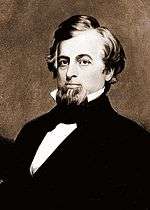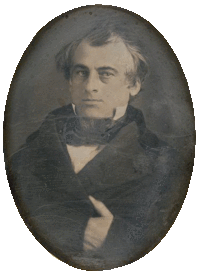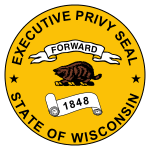William A. Barstow
| William Augustus Barstow | |
|---|---|
|
William A. Barstow in 1853 | |
| Born |
September 13, 1813 Plainfield, Connecticut |
| Died |
December 13, 1865 (aged 52) Leavenworth, Kansas |
| Allegiance |
|
| Service/branch | Union Army |
| Rank | Brigadier General |
| Battles/wars | American Civil War |
William Augustus Barstow (September 13, 1813 – December 13, 1865) was the third Governor of Wisconsin and a Union Army General during the American Civil War.
Early life
Barstow was born in Plainfield, Connecticut. He worked with his brothers in business in Norwich, Connecticut and Cleveland, Ohio, but moved to Waukesha, outside of Milwaukee, after the Panic of 1837, where he started a mill. He was active in local politics, serving on the Milwaukee County Board, and in 1846 led a movement to separate Waukesha County.
Barstow served as the Wisconsin Secretary of State from 1850 until 1852. He was elected the governor of Wisconsin as a Democrat, taking office on January 2, 1854. As governor, Barstow supported the railroad to the Pacific and stood against the attempts of the Know-Nothing movement to undermine the citizenship of the foreign-born. He opposed prohibition of alcohol sales, and vetoed a ban passed by the Legislature despite strong public support. However, allegations that his administration had misused public school funds and favored personal friends in state funded loans proved to have greater impact than his positions on issues. Although he was renominated by the Democrats, Barstow lost support within his party as well as in Wisconsin generally.
Disputed election

When Barstow ran for reelection in 1855, he was initially declared the winner against his Republican opponent, Coles Bashford, by a mere 157 votes. However, Bashford claimed the result was fraudulent, and it was soon substantiated that Barstow's win was due to forged election returns from nonexistent precincts in the sparsely populated northern part of the state, in addition to other irregularities such as two separate canvassing boards claiming legitimacy in Waupaca County and attempting to submit conflicting certifications. As rival militia units converged on the state capital in Madison, threatening to start a civil war within the state, Barstow was inaugurated in a full, public ceremony on January 7, 1856. On the same day, Bashford was also sworn in quietly as governor in the chambers of the Wisconsin Supreme Court by Chief Justice Whiton. The Wisconsin attorney general filed quo warranto proceedings in the Wisconsin Supreme Court to remove Barstow, who threatened that he would not "give up his office alive." After challenging the court's jurisdiction without success and noting that the tide of public opinion had turned against him, Barstow declined to contest the fraud allegations and sent his resignation to the legislature on March 21, 1856, leaving the lieutenant governor, Arthur MacArthur, as acting governor. On March 24, the court unanimously awarded the governorship to Bashford by a count of 1,009 votes.
Later life
Barstow moved to Janesville, Wisconsin, where he opened a bank and promoted various railroad construction schemes. He remained in politics following the election scandal, serving as a Wisconsin delegate to the Democratic National Convention in 1860. After the start of the Civil War, however, he joined the Union war effort and under the authority of the War Department in 1861, he organized the 3rd Wisconsin Cavalry regiment at Camp Barstow, near Janesville. He commanded the regiment as a colonel and was appointed Provost Marshal General of Kansas, operating out of Fort Leavenworth. Due to failing health, however, Barstow was reassigned in the summer of 1863 to preside over courts-martial in St. Louis, Missouri, and he never rejoined his regiment. He was promoted to brigadier general of volunteers on March 13, 1865, nine months before his death in Leavenworth, Kansas.
See also
References
- 3 governors held office within weeks, Dennis McCann. Milwaukee Journal Sentinel, December 10, 1998.
- Attorney General ex. rel. Bashford v. Barstow, 4 Wis. 567 (1856)
Further reading
- Toepel, M. G.; Kuehn, Hazel L., eds. (1960), The Wisconsin blue book, 1960, pp. 79–82
External links
 Media related to William A. Barstow at Wikimedia Commons
Media related to William A. Barstow at Wikimedia Commons- Regimental history of the Third Wisconsin Cavalry
- Biographical capsule from the Wisconsin Historical Society
| Political offices | ||
|---|---|---|
| Preceded by Thomas McHugh |
Secretary of State of Wisconsin 1850–1852 |
Succeeded by Charles Robinson |
| Preceded by Leonard J. Farwell |
Governor of Wisconsin January 2, 1854 – March 21, 1856 |
Succeeded by Arthur MacArthur, Sr. |


